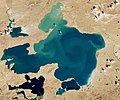English: Through episodic and regional studies, scientists have observed that phytoplankton blooms have been occurring more often in lakes around the world in recent decades. But until recently, no one had assembled a global, wholistic view of the phenomenon. Scientists from Stanford University and NASA recently decided to measure the blooming trends globally. What they found was discouraging.
Working with the long satellite record from Landsat, Stanford environmental scientist Jeff Ho and colleagues examined 71 lakes in 33 countries on six continents. They focused on summertime conditions in large lakes (greater than 100 square kilometers/40 square miles) with different physical settings, latitudes, and levels of human impact.
They used computers to analyze nearly 32,000 images spread across 28 years, training the computer to detect strong near-infrared signals. Phytoplankton blooms have high concentrations of chlorophyll, the same pigment that helps land-based plants absorb sunlight to make energy. Chlorophyll tends to reflect near-infrared light and absorb blue and green light, so intense blooms produce strong near-infrared signals in infrared imagery.
The researchers found that phytoplankton blooms over the years typically followed one of four trends: sustained improvement (blooms decreasing), deterioration (blooms increasing), improvement then deterioration, or no significant trend. Across the study period (1984 to 2012), peak summertime bloom intensity rose considerably in 48 out of the 71 lakes (68 percent). Most of the deterioration increased in the latter years of the study period.
“Toxic algal blooms affect drinking water supplies, agriculture, fishing, recreation, and tourism,” explained lead author Ho. “Studies indicate that just in the United States, freshwater blooms result in the loss of $4 billion each year.”
One of the common reasons for lake deterioration is nutrient overloading—the accumulation of excess dissolved nutrients in the water from runoff and fertilizer. Excess nutrients such as phosphorous and nitrogen can promote the growth of massive colonies of algae. Sometimes those blooms are directly toxic to other marine species and humans who consume them. Other times, large blooms can suffocate marine life by depleting the oxygen in the water (hypoxia). Lakes are at a higher risk for these sorts of blooms when they have less circulation from rivers flowing in and out; sustained warmer water temperatures; or variability in lake composition, where no one section of the lake has the same physical and chemical makeup.
Siling Lake (or Sèlin Cuò) in Tibet is one lake that has had a steady increase in blooming intensity since 1995. The lake includes protected wetlands (a Ramsar site) and is major stopover for birds migrating through the region. Most of the land around the lake is used for grazing yaks, sheep, and other livestock, a factor that could contribute to blooms. The natural-color image at the top of this page was acquired by the Operational Land Imager on Landsat 8 on September 12, 2017.




